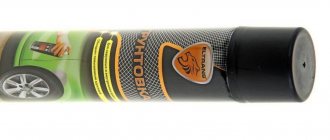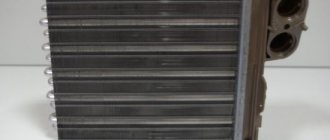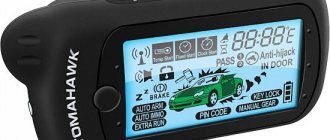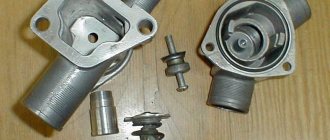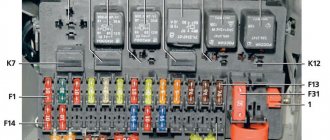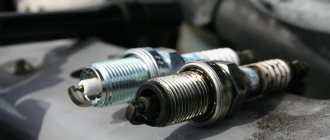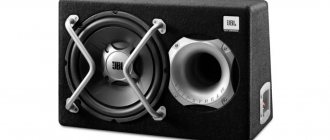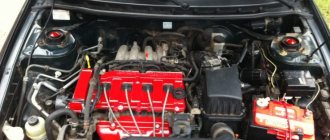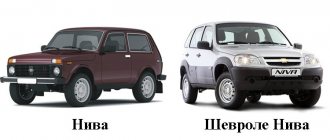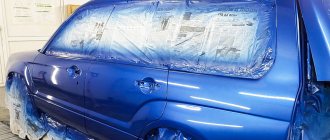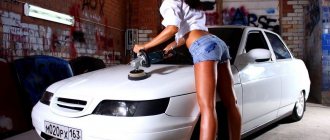Why is an acid primer needed and what is it? Other names for such auto chemical products that you can hear are phosphating, etching, reactive primer, wash primer. Its main properties are high adhesion and anti-corrosion effect. Therefore, the purpose of acid soil is to protect the metal of the car body from rust. Why is the soil called acidic? This is explained by the fact that it is cured with acid.
What is oxygen primer for a car?
An acid-based primer is a special primer that comes in cans or containers with liquid. The main application is to improve adhesion and anti-corrosion protection.
The product is suitable for treating car bodies and is used as an initial layer.
It is impossible to apply a paint coating or epoxy composition over this product, since additional painting suppresses the acidic properties of the primer.
Preparing the body for priming
The key to successful processing is careful adherence to technology at every stage. Let's highlight the most significant:
- Determination of the processing location (room) where the work will be carried out.
- Cleaning the entire surface of the car from dirt and dust deposits.
- Thorough inspection of the car and selection of paintwork.
- Applying a protective coating (material or construction film) to areas that cannot be treated.
- Degreasing the substrates and sanding them using abrasives.
- Applying a putty layer.
- Surface treatment with anti-corrosion coating.
Cleaning and degreasing is best done with a brush or aerosol can. The use of the latter helps to obtain a fairly uniform coating. After this, you can begin the phase of applying the acid layer.
Before starting work, you must prepare the following personal protective equipment:
- respirator;
- protective clothing and footwear;
- protective gloves for hands.
Exposed metal parts of the car body are exposed to rust, so minor damage can give rise to the development of a corrosion process.
Acid primer applied to the vehicle base will act as an intermediate layer between the metal body and the paint layer.
Select and buy a high-quality primer correctly, otherwise all the flaws in the paint coating will be noticeable.
Main varieties
You can find 2 types of acid soil on sale:
- Based on 1 component.
- Based on 2 components.
One-component
Phosphate primer based on 1 component can be used without prior preparation. It can be purchased in cans for application without auxiliary equipment or in containers with a liquid solution. The second option is applied with a spray gun in 1 thin layer. When the coating acquires the required properties, it can be treated with acrylic with the inclusion of a hardener.
Two-component
Before applying the product to a metal surface, it should be properly prepared. The instructions mention the need to mix the main substance with the activator. The final consistency takes on both hard and soft forms. Experts advise choosing the first option, as it creates a strong and reliable film over the entire treated area. It is allowed to apply primer in 1, 2 or 3 layers, observing the proportions and basic recommendations of the manufacturer. There is a 5 minute pause between reuses.
What is the difference between acid primer and epoxy primer?
Epoxy primer is a substance that includes epoxy resin, fillers, polymers, and some alcohol derivatives. The primer, after application, creates a film that does not allow oxygen to pass through. After hardening, the soil does not allow water to penetrate at all, since it does not form pores. Epoxy primer is available in a can or in jars.
Epoxy primer in cans Source sevparitet.ru
Epoxy Primer Differences
According to experts, epoxy primer should be applied directly to clean metal and then putty. This is especially important if the metal is being restored over several weeks, i.e. for a long time.
For example, if a car sits in a garage for a long time, then, since there is humidity in the room, the areas of the body that have been stripped down to metal will begin to oxidize. In this case, you can choose the option of puttying with an epoxy primer. Then the putty should be applied before the primer has completely hardened.
Differences in acid soil
When it comes to acidic soil, you can hear the following names: phosphating, etching, reactive. The primer in this embodiment is a compound of zinc and phosphoric acid. More precisely, it consists of:
- polyvinyl butyral, which is a synthetic material and serves to form good adhesion and film;
- zinc phosphates and chromates;
- water;
- phosphoric acid, which is an excellent rust converter;
- alcohol.
Composition of acidic soil Source strport.ru
The operating principle is approximately this: phosphoric acid acts on the metal and, at the same time, zinc is precipitated. The film is formed by polyvinyl butyral - the acrylic layer will already adhere tightly to it. After applying the primer to the metal surface, a thin coating is obtained. It is an anti-corrosion and adhesive layer. The primer does not completely destroy the rust that is already there, but it also does not allow it to spread.
Acid primer for cars is divided into four main types:
- One-component.
Acid primer is often sold in a can to make processing easier. You can also use a can of primer to spray it with a spray gun. The composition does not need to be prepared - it can be used immediately. When the soil hardens, you can begin to treat it with an acrylic composition to which a hardener has been added.
- Two-component.
If you purchase a two-component primer, you must prepare a primer. To do this, it is mixed with an activator, and the consistency can be different - hard or soft.
Two-component primer Source autocosmetica.by
See also: Catalog of companies that specialize in paints and varnishes.
Professionals prefer to work with a solid form, as it gives the strongest film. Depending on the recommendations in the instructions, the two-component composition can be applied in 1, 2, 3 layers. During treatment, maintain an interval of approximately 5 minutes between applications.
- Reactive.
This option is used for clean surfaces. The reactive substance forms a very small layer (8-13 microns). This is the base on which the following layers should be applied.
- Self-Etching primer.
This substance is a soil with the addition of zinc. Used to eliminate unevenness and improve the quality of adhesion. The substance acts on the metal, resulting in the creation of a layer of frozen polymer elements.
Self-Etching primer Source alicdn.com
You can choose a one- or two-component primer, but most craftsmen use a material that has two ingredients. The greatest wear resistance is achieved through filler primer - this is a necessary stage of coating.
Pros of primer in cans
Primers in the form of aerosols have several important advantages:
- Ease of use. There is no need to use special equipment to distribute the soil.
- High quality finishing coating. The can ensures uniform distribution of the composition over the surface being treated.
In most cases, an aerosol primer is used for local application to metal products.
If you need to treat large areas, it is better to use an air gun.
Primer in the form of a spray is used by beginners who have not carried out body repairs before. Using an aerosol, you can level paintwork materials and get an even and beautiful coating.
Let's sum it up
Today it is difficult to protect a car from all the influences of a rather aggressive and difficult operating environment. A large amount of moisture, difficult winter travel conditions, poor quality of repair work and body restoration - all this affects the service life of expensive vehicle components.
If you want to preserve car parts and extend their life, you should use special effective processing methods. A special layer of primary metal processing using acids is ideal.
Etching the surface saves the car owner from various troubles. Also, this procedure allows you to better organize the paint layer and ensure a long and comfortable life of the paint. But to achieve such goals, you should study all the features of applying etching compounds in order to carry out each task in accordance with the requirements. This will help you get the results you want.
Preparation stages
To obtain a high-quality surface, you should perform a number of preparatory actions and adhere to a strictly proven algorithm:
- First of all, you should prepare the room in which the body will be painted.
- Then you need to clean the surface from rust, dirt, dust and old putty.
- Next you need to inspect the machine and prepare a suitable enamel composition.
- After this, it is necessary to protect the body parts that do not need to be treated and degrease the surfaces.
- At the next stage, putty is applied and an anti-corrosion layer is formed.
Selecting a Protective Primer
The surface of the car is very vulnerable. The slightest scratches, chips or other damage to the body instantly destroys the metal with corrosion. Primer in minor repair work is an intermediate link that is laid between the final layer of paint and the surface of the body. You can even say that the soil is a kind of foundation, the choice of which determines the quality of the paint surface. There is no need to skimp on primers.
A prerequisite for good primer application is the preparation of the car body, which can be made of aluminum or steel. Moreover, the latter can be galvanized, stainless, pure or chrome-plated.
If the primer is chosen incorrectly (the owner of the car decided to save money), the paint sags over time, unaesthetic puddles appear on the surface of the car and scratches from sandpaper become visible.
Any automotive primer has excellent adhesion to the body. The standard thickness of its application is from 15 to 20 microns. Division of primers:
The most common auto primer that protects metal consists of two components. Can be soft or hard. The last option is the highest quality, forming a durable and reliable coating with a long service life.
Application methods
Acid primer can be applied using several methods and tools:
- Simple brush.
- Spray gun.
- By lowering a metal product into a solution.
- Electrical spraying.
- Using electrodeposition technology.
In everyday life it is customary to use the first 2 tools. Immersion technology is used in factories.
Is it possible to apply paint to acidic soil?
Experts do not recommend applying paint over a layer of one-component acid primer. Otherwise, the components may cause a change in the shade of the paint due to the action of the yellow pigment.
What is the peculiarity of the composition
Acid primer for cars is a strong substance that ensures sufficient resistance of the frame to moisture and helps destroy rust. To completely remove rust before applying paint, it is recommended not to skimp on primer and buy a product from trusted brands.
The acid primer is based on phosphoric acid and a zinc additive. The product is applied exclusively as the first layer, that is, sprayed directly onto the metal. Before use, the surface must be degreased, this will help remove particles of rust and grease. Drying time at room temperature (20 °C) is 15 minutes.
When the composition has completely set, you need to additionally walk over the area with an acrylic primer. It helps to even out the layer. It is better to apply the composition to the seams with a brush. If you need to treat large areas, you should choose a spray bottle.
Acid primer is a mixture of phosphoric acid and zinc, it is primary and is sprayed directly onto the bare metal
Important! Do not apply the composition to old putty or poorly cleaned metal, otherwise the subsequent coating will peel off over time. Acid primer is applied only to clean, degreased metal; if there are old coating particles, you can use acidic epoxy primer.
In each case, the substance requires subsequent coating with a 2-component primer and filler. When high-quality preparation has been completed, you can begin coating with an additional layer of primer, putty and paint.
You cannot apply other compounds directly to the acid coating, the only exception being an insulating primer. Etching is a critical vehicle prep and treatment procedure to ensure metal integrity and corrosion protection. Welding seams are always coated with the substance.
Rating of the best brands
When choosing which primer to buy for a car, you should familiarize yourself with the following product brands:
- DUR 1:1. The reactive solution provides a durable film with improved adhesive properties. The advantage of the composition is the absence of chromates and the presence of a special reaction catalyst in the kit.
- Body 960 Wash primer. Suitable for different surfaces and consists of 2 components. During application it is mixed with hardener.
- Mobinel. A one-component product with high anti-corrosion characteristics. Suitable for stainless steel, galvanized and aluminum.
Priming Features
Bare metal needs protection from corrosion. Therefore, many services specializing in auto painting use acid primer to create a durable base for paint. The procedure is called “louse primer”; the composition retains its performance characteristics for 24 hours after mixing the 2 components. A distinctive feature of reactive primer is that it can and even needs to be sanded. For this, sandpaper with a grain size of P400 is used.
An acidic 2-component auto primer is applied in stages, maybe 1-3 layers with an interval between stages of at least 5 minutes. The metal takes about half an hour to one and a half hours to dry.
Filler is applied on top of the etching primer, but in no case is polyester-based putty. The use of the latter can dissolve the protective coating of aluminum or steel, nullifying all the efforts of the master.
Important: the reverse application algorithm, that is, acid primer on putty, is possible.
Technical characteristics and features of Novol reactive primer
Novol Protect 340 is a two-component reactive (or acidic) primer, free of chromium salts, which consists of the following components:
- suspension of pigments and filler in a mixture of high-quality resins;
- hardener based on orthophosphoric acid.
The reactive composition is applied directly to the rust source and is primary. This means that it cannot be painted immediately. A layer of secondary primer is always applied over the acid primer. The Polish product Novol Protect 340 is an ideal base that guarantees strength and excellent adhesion of subsequent layers. It has excellent technical characteristics:
- high strength and wear resistance;
- resistance to salts;
- excellent hydrophobicity;
- good adhesion;
- resistance to mechanical stress.
The acid composition Novol Protect 340 can be applied to aluminum, nickel-plated, chrome-plated, galvanized steel.
It is important to remember that the mixture is highly flammable and highly toxic. The material is easy to use; in order to apply it to the surface with your own hands, you do not need special knowledge and skills. The instructions for use will help you do this quickly and efficiently.
Acidic, phosphating, etching or reactive primer?
All these names, one way or another, refer to soil that contains acid. In English, there are three different names for acid soils, which are also indicated on packages sold in Russia. Etch or etching primer - etching primer, self etch/etching primer - etching primer, which has ingredients that immediately after the action of the acid are eaten into the metal, creating anti-corrosion protection, wash primer - reactive primer, which also contains acid and, in theory, is intended for application to new metal that does not contain old putty and paint to increase adhesion (especially non-ferrous metals, such as aluminum).
Some acidic soils are not “strong” enough to attack steel. You need to look at the technical specifications of the product.
Different manufacturers have different primer formulas and instructions for use. Initially, etching primers did not contain components that increase corrosion protection and, especially, fillers that fill small irregularities. Nowadays you can find acidic soils from different manufacturers that contain anti-corrosion additives and can be used as fillers at the same time. Most often, however, a good acidic primer is able to chemically act on any metal, preparing it for the next layer of filling primer, and also converts a small amount of difficult-to-clean rust and passivates the surface of the metal, making it inactive to oxidation, and therefore to corrosion.
Types of material: one-component aerosol, two-component formulations
Acid anti-corrosion primer belongs to the category of primary primers (novol, body 960), which treat the surface of the car with a uniform thin layer in order to prevent rust from spreading.
Important! Painting a car over such a primer is strictly prohibited.
After drying these primers, secondary primers must be applied.
The main properties of reactive primers, including the body and novol brands, are wear resistance, resistance to aggressive salt environments and moisture. They are well preserved under various mechanical, chemical or atmospheric influences.
There are:
- one-component primary ones that do not require the addition of a catalyst. These include, for example, mobihel brand soil; they are also available in aerosol cans;
- two-component primary. A hardener must be added to such primers.
Phosphoric acid is added as such to acidic soil, which, when it reacts chemically with synthetic resins, anti-corrosion and organic pigments, generates heat.
However, it is not capable of melting dishes, even those made of plastic. These include brands body 960, novol protect 340 wash primer.
Useful! Acid primer is perfectly applied to such car metal surface materials as: aluminum, galvanized, chrome-plated and stainless steel coatings, welding seams, iron, and many others.
Types of primers with zinc
The zinc primer must be selected taking into account the type of surface and operating conditions. Zinc primer is applied to ferrous or non-ferrous metals. There are different types of phosphating, passivating, insulating, inhibiting and protective mixtures.
The phosphating type of primer is a two-component one, in the manufacture of which phosphoric acid with a diluent is used. This mixture improves the quality of adhesion.
Insulating zinc primer can be alkyd or epoxy; it protects surfaces from moisture and oxygen compounds. Such primers are used to protect ferrous metals.
Passivating zinc primer for metal surfaces slows down the corrosion process.
The inhibitory mixture promotes the formation of a new type of substance on the surface, similar in type to enamel primer, combining the properties of both compositions.
The next type, a protective primer, is used to treat rusty surfaces; it has an alloy of magnesium with zinc, as well as lead powder. Due to the content of zinc particles, once applied to the metal surface, the coating, invisible to the normal eye, protects metal substrates from scratches.
Alkyd paint for metal can be used as an independent coating. No paint or enamel is required over this primer. It provides excellent anti-corrosion characteristics and also stops the rusting process.
This shows that alkyd primer is capable of providing reliable protection against various atmospheric phenomena and UV exposure.
Primer in aerosol cans
If you need to treat small areas or need to apply primer to hard-to-reach areas, you can use insulating primer in aerosol cans. This option is easy to use, since the zinc primer is applied evenly and dries quickly.
The aerosol is always a one-component composition, it is completely ready for use, no additional manipulations are required. It helps with quick local coating repairs. This is the convenience of sprays.
It is suitable for treating the following types of surfaces:
- ferrous metals;
- chrome steel;
- galvanized steel;
- light alloys;
Aerosol soils are convenient, practical, profitable, and available for use.
Two-component zinc primers
A two-component zinc-rich primer consists of a zinc-rich epoxy base and a solvent, used for finishing painting with epoxy and polyurethane paints to protect metal coatings from corrosion. The kit includes two separate containers with base and diluent. The base consists of a mixture of polymer resins and zinc filler. The diluent contains isopropyl alcohol with orthophosphoric acid and auxiliary substances.
Due to the high zinc content, this primer is used to protect steel surfaces from corrosion.
The two-component epoxy primer has a high level of moisture resistance. After the composition dries, it forms a dense water-repellent film on the surface, which protects against the appearance of corrosive formations during prolonged exposure to moisture on the metal.
In addition, it has high strength and high durability, resistance to household chemicals, alkalis and acids, as well as to atmospheric influences, and is not susceptible to sudden temperature changes or exposure to sunlight.
Two-component primers have excellent adhesion to the surface.
But two-component mixtures dry slowly, the drying time lasts up to 12 hours.
Zinconol
Zinconol is a product with a high zinc content (at least 94%) and is used for cold galvanizing of metal structures. They call it “liquid zinc”. When interacting with air, it provides a durable, reliable coating and protective protection against corrosion.
Zinconol is used both as an independent protector and together with protective enamels, increasing the strength of the anti-corrosion protector in aggressive conditions. But even without additional protection, Zinconol provides a guarantee of protection against corrosion of metal structures. After treatment, surfaces acquire resistance to oxidation with oxygen, resistance to acids, alkalis, oil products, sea and fresh water and high temperatures.
Some tricks for working with aerosol primer
In construction or repair work, sometimes you have to deal with very rusty metal surfaces. But few people know that it is not at all necessary to completely clean them; it is enough to remove fragile fragments of rusty scabs with sandpaper, which may fall off during further work. After this step, it is possible to apply the primer directly to the rust.
It happens that when coating small objects, there is an overconsumption of the mixture, i.e. you can get by with a small stroke, but a volumetric jet bursts out of the nozzle. In this case, you can simply extract a little liquid from the bottle itself, just direct the stream so that it touches the inner wall of the jar, glass or any other small container.
After this, you should stir the primer liquid so that excess gases come out of it.
Now you can simply dip a brush and prime a small object with it without wasting a lot of material. It is important to remember that the temperature limits when working with aerosol primer are no higher than +30 and no lower than +10C
